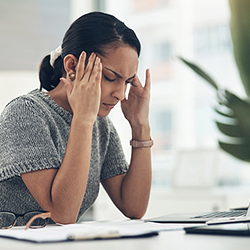
Every day, roughly 16 million Americans suffer from a headache. For the majority of those folks, what they’re experiencing is a tension headache. While this type of headache can be brought on by a slew of different reasons, relief can also be found through an equally diverse number of measures—several you can easily do yourself.
Tension headache or migraine?
According to Dr. James A. D. Otis, a neurologist at Baystate Neurology and Director of Baystate’s Headache Clinic, “The first step in treating any headache is figuring out what kind of headache it is. Tension headaches and migraines are the two most common primary headaches. While both cause discomfort, the nature of the pain experienced is quite different. These differentiators help in determining the type of headache being experienced and ensures it’s treated as effectively as possible.”
Do I Have a Tension Headache or a Migraine?
| Feature |
Tension Headache |
Migraine |
| Age of onset |
Any age |
Adolescence |
| Gender |
Affects men and women equally |
More common in women than men |
| Pain experienced |
Dull, steady pain, pressure, or tightness on both sides of the head; often described as “hat band pain” |
Moderate to severe pulsating or burning pain, often on one side of the head |
| Duration |
30 minutes to 7 days |
4 hours to 3 days |
| Additional symptoms |
Muscle tenderness in the scalp, neck or shoulders |
Nausea and vomiting; extreme sensitivity to light, sound and strong smells; aggravated by movement; tingling or numbness can spread to one side of your face and tongue; dizziness |
Causes and treatment for tension headaches
While the specific cause of tension-type headaches is not known, the most common triggers include stress, alcohol, jaw clenching, tooth grinding, eye strain, caffeine, and sleep deprivation.
“In my experience,” says Otis, “the lack of sufficient restful sleep is often at the root of tension headaches. Frequently patients will say they get plenty of sleep but upon further questioning you learn that they get up several times in the night to use the bathroom or to tend to pets or children. Or they fall asleep with the television on. In both instances, your brain never reaches the deepest phase of sleep when it signals the neck and shoulders to relax. Whatever tension exists there, remains there.”
Noting that treatment for tension headache is very specific to the individual, Otis adds, “If you’re having this type of headache every now and then, over-the-counter pain relievers may effectively treat the pain. The trick is to not overmedicate, which can actually bring on a rebound headache. This type of headache is difficult to treat and can severely impact your quality of life. To avoid that, you want to limit use of pain relievers to no more than two times per week. If over-the-counter pain relievers don't provide relief, stronger medication may be prescribed.”
Finding headache relief through self-care
Other options for headache treatments that don’t require prescriptions or over-the-counter medication include:
For Immediate Relief
Ice: apply to both sides of the neck and shoulders, or, to the forehead and temples if experiencing pain there
Take a break: step away from any work that requires concentration or prolonged neck strain for at least 20 minutes
Self-massage:
- Head massage: hook your thumbs a few inches behind your ears at the base of your skull. Gently rub until it hurts then hold and apply pressure for 10 seconds. Repeat 5 to 6 times.
- Shoulder blade squeeze: push your shoulder blades back and squeeze toward the center of your spine. Hold for 10 seconds. Repeat 5 to 10 times.
- Head rotation exercise: holding your body still, turn your head to look over one shoulder. Use your hand to apply a bit more pressure and bring on a stretch in your neck and hold for a count of 10. Repeat on the other side.Head tilt: tilt your head to one side, dropping your ear towards your shoulder. Hold for a count of 10. Repeat on the other side.
For Long-Term Prevention
Structured massage therapy or deep tissue massage: works to relax strained muscles that may be the root cause of headache pain
Mindfulness training: teaches you how to quiet your mind so that you can get a more restful sleep
Cognitive behavioral therapy: helps you recognize stress triggers and how you respond to them, helping to relieve anxiety
Exercise and meditation: relieve muscle tension
Develop your sleep hygiene routine for better sleep
When to see a doctor for headaches
If you’re experiencing two or more tension headaches a week over a six-month period or are finding them disruptive to daily living, make an appointment to see your doctor.
If you experience an abrupt, severe headache or one that causes changes to your vision, weakness, or a tingling or numbness you’ve never had before, seek emergency help.
To learn more or make an appointment, contact our Headache and Migraine team.